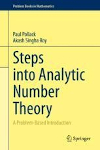- About MAA
- Membership
- MAA Publications
- Periodicals
- Blogs
- MAA Book Series
- MAA Press (an imprint of the AMS)
- MAA Notes
- MAA Reviews
- Mathematical Communication
- Information for Libraries
- Author Resources
- Advertise with MAA
- Meetings
- Competitions
- Programs
- Communities
- MAA Sections
- SIGMAA
- MAA Connect
- Students
- MAA Awards
- Awards Booklets
- Writing Awards
- Teaching Awards
- Service Awards
- Research Awards
- Lecture Awards
- Putnam Competition Individual and Team Winners
- D. E. Shaw Group AMC 8 Awards & Certificates
- Maryam Mirzakhani AMC 10 A Awards & Certificates
- Two Sigma AMC 10 B Awards & Certificates
- Jane Street AMC 12 A Awards & Certificates
- Akamai AMC 12 B Awards & Certificates
- High School Teachers
- News
You are here
Steps into Analytic Number Theory

Publisher:
Springer
Publication Date:
2021
Number of Pages:
210
Format:
Hardcover
Series:
Problem Books in Mathematics
Price:
59.99
ISBN:
978-3-030-65076-6
Category:
Problem Book
The Basic Library List Committee recommends this book for acquisition by undergraduate mathematics libraries.
[Reviewed by , on ]
Allen Stenger
06/20/2021
This book is full of interesting problems and results, most of them not found in books. It is structured as a problem book, with problems in the front and solutions in the back. It excludes complex-variable methods (except a little bit in Dirichlet’s Theorem). Only real-analysis methods are used (and really nothing past calculus), so there is an emphasis on inequalities and on approximation with integrals. There’s also quite a lot on combinatorial methods, not closely tied to analysis.
The prerequisites are not stated explicitly; the problems were given as a summer course in China to a mixture of students, mostly in high school. “Participants were expected to have a strong background in mathematical problem solving (e.g., from training for mathematics contests) but not assumed to possess advanced subject-matter knowledge.” Many of the problems require ingenuity, so for a US market I think it fits best at the upper-division undergraduate level, and could be an introductory course to number theory.
There are a total of 163 problems, divided into fifteen “steps”. Each step deals with a set of related problems; the last three steps together give a proof of Dirichlet’s theorem on primes in arithmetic progressions. The book has a very strong orientation to specific problems and does not develop a body of methods (although many simple methods, such as the Inclusion-Exclusion Principle, and some more complicated methods, such as Gauss sums, are discussed and used).
The general types of problems covered fall into three categories: distribution of values of arithmetic functions, distribution of prime numbers, and distribution of quadratic residues. Specific results that are proved include, in addition to Dirichlet’s Theorem: Chebyshev’s estimates on the number of primes, Mertens’s estimate for \( \sum_{p \leq x} 1/p \); Brun’s theorem on twin primes; the Pólya–Vinogradov inequality; and Vinogradov’s bound on the smallest quadratic non-residue mod p. The Prime Number Theorem is not covered, which I think is a reasonable omission because all the non-complex variables proofs are very mysterious and would be hard to structure as problems for this audience.
All problems have fully worked out solutions rather than hints that are easy to follow. Sometimes there are alternative solutions, and sometimes further results are stated with references.
The book has no index. It is also weak on references: there is a good list of Suggestions for Further Reading on p. 197, and the solutions sometimes mention further results and give references for them. Some of the exercises name the author of the result, but there is no bibliographic information.
Another good book with a similar title but not much overlap is M. Ram Murty’s Problems in Analytic Number Theory. This book is much more advanced and makes heavy use of complex analysis. A good introduction to analytic methods, although more advanced, more concise, and not structured as a problem book, is Donald J. Newman’s Analytic Number Theory. It emphasizes a generating-function approach, which is a good way to see the links between the discrete and the continuous.
Bottom line: This is an excellent and probably unique introduction to the use of continuous methods in the discrete world of number theory, and accessible to a wide mathematical audience.
Allen Stenger is a math hobbyist and retired software developer. He is an editor of the Missouri Journal of Mathematical Sciences. His personal web
site is allenstenger.com. His mathematical interests are number theory and classical analysis.
See the publisher's website.
- Log in to post comments




